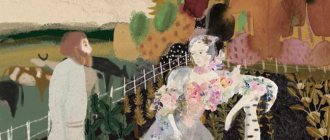History of creation
The poem “Leaf” is one of the best works of the late period of the poet’s work.
Created in 1841 , it reflected the mental suffering of M. Yu. Lermontov, who, after a short vacation in St. Petersburg, was forced to return to exile in the Caucasus.
The poem was published after the tragic death of the poet in 1843.
M. Yu. Lermontov borrowed the image of a homeless lonely leaf from the elegy of the French poet A. V. Arno.
Subject
- Loneliness is one of the dominant motives of M.Yu. Lermontov. It is this theme that is the main one in the poem “Leaf”, and the line of vagrancy acts as a side theme. The lyrical hero finds himself completely alone in unfamiliar lands, far from his homeland. This internal drama is intensified by the refusal of the arrogant plane tree to shelter the poor wanderer. The leaf embodies the image of a tramp, with all the characteristic features: he has no pride, is ready to complain if he could, probably would fall to his knees, just to get “shelter for a while.”
- The motif of an exotic country to which the hero strives is characteristic of romanticism. But it is worth considering that this was written in a late period of the era and by a mature author who knows what disappointment is.
Image system
The main images of the work are opposed to each other. They are oak leaf and plane tree. The suffering of a homeless, wind-battered leaf becomes clearer against the backdrop of the sunny world of the green plane tree.
The reader meets episodic characters who complement the figurative series of the poem. In the first lines, an image appears of a fierce storm that forced an oak leaf to wander around the world. The pampered plane tree is surrounded by a gentle wind and birds of paradise.
Composition of the poem “Leaf” by M. Yu. Lermontov
The composition of the work is simple - it is built on opposition. Plane and oak leaves are contrasted here with each other. An analysis of the poem “Leaf” by Lermontov reveals that the use of antithesis aggravates the conflict of central images. The oak is yellow and lethargic, and the plane tree is green and fresh, the oak leaf is a wanderer, and the plane tree is static. The plane tree leaf is friendly with the world, but the oak tree does not see harmony in anything.
The culmination of the work is the final collapse of the protagonist’s hopes of finding happiness and peace in the real world. The feeling of tragedy is also aggravated by the fact that the plane tree leaves the last word for itself.
The ending of the poem is open. But this does not prevent one from hearing in it echoes of the collapse of hopes for happiness. Most likely, the hero is doomed to death or painful wanderings far from his home. The conflict between faith in a dream and reality in the poem reflects the feelings of the poet himself.
Plot
The storyline of the poem is connected with the main characters.
First, the reader is introduced to an oak leaf that cannot withstand a fierce storm. He wanders around the world, looking for shelter, suffering hardships.
Once on the shore of the Black Sea, the leaf hopes that it will finally rest and warm up “between the leaves... emerald” of the beautiful plane tree.
However, his dreams were not destined to come true. The young plane tree does not want to see a wretched, dried leaf next to it. “Go further, O wanderer! I don’t know you!” she answers pleas for help and compassion.
The open ending of the story conveys the feeling of doom of the oak leaf. The last words are spoken by the plane tree, which does not want to disturb its cozy peace. The oak leaf remains lonely as before.
Analysis of Lermontov's Poem "Leaf"
Perception, interpretation, evaluation
The poem “Leaf” was written by M.Yu. Lermontov in 1841. The image of a leaf driven by a storm was widespread in Russian and European literature and was developed in the works of A. Arno, V.A. Zhukovsky, I.I. Kozlova.
The theme of the poem is the homelessness of a lonely soul in a cruel, hostile world. We can attribute the poem to philosophical lyrics, with elements of landscape.
The poem contains an allegory symbol. The fate of a leaf torn from a “native branch” is the fate of a wanderer who has lost his homeland. The motif of a wanderer and exile has always been characteristic of Lermontov’s work (poems “Clouds”, “Branch of Palestine”, “Sail”). The images of nature in these works are allegorical and symbolic, with their help the inner world of the lyrical hero is revealed. We see the same thing in the poem “Leaf”.
Lermontov’s oak leaf tore “from its native branch,” became the victim of a fierce storm, experienced a lot of grief along the way, and finally reached the Black Sea. He sees a young, beautiful plane tree, tries to find shelter and shelter, but all his attempts are in vain. Chinara is satiated with life's impressions, she values her peace very much, she is imbued with a sense of her own superiority, and is filled with narcissism. The fate of the unfortunate leaf leaves her indifferent. There is no place for pity or sympathy in her heart. The leaflet's story about his harsh Fatherland, about his restless fate and wonderful wanderings around the world does not give rise to either interest or curiosity in her soul. Chinara is hostile towards the tired traveler:
Go further, O wanderer! I don't know you!
I am loved by the sun, I bloom and shine for him;
I spread branches across the sky here in the open space,
And my roots are washed by the cold sea.
The images of the leaf and plane tree in this work are antithetical. In an allegorical form, using the technique of personification, M.Yu. Lermontov conveys the main idea of the poem: in this world there is no place for pity and compassion, a lonely soul cannot find shelter anywhere, well-being and happiness are deaf to troubles, sorrows and loneliness.
The poem is written in amphibrachic pentameter. The poet uses various means of artistic expression: epithets (“with deep melancholy”, “between her emerald leaves”, “sophisticated and wonderful stories”), personification (“the wind whispers with her”), inversion (“Running around the world alone and without a goal I've been around for a long time"). At the phonetic level, we find alliteration (“A young plane tree stands by the Black Sea”) and assonance (“An oak leaf has broken away from its native branch”).
Artistic originality of the work
The syntactic sequence of the poem is unusual. Non-union sentences describe the suffering of the oak leaf in the first lines of the work. Exclamation marks help one feel the indignation of the plane tree. Dialogue makes the characters’ images clearer and more realistic.
The trisyllabic meter of the verse (amphibrach pentameter) gives the poem a unique originality. Different types of rhyme (paired and cross) correspond to changes in intonation and mood when describing the characters of the work. The use of female rhyme makes the work melodious and melodic.
Lermontov "Leaf". Text and Analysis of the Poem
An oak leaf tore itself from its native branch and rolled off into the steppe, driven by a cruel storm; It withered and withered from the cold, heat and grief, and finally reached the Black Sea.
A young plane tree stands by the Black Sea, The wind whispers with it, caressing the green branches, Birds of paradise sway on the green branches; They sing songs about the glory of the Tsar-Maiden of the Sea.
And the wanderer pressed himself at the root of a tall plane tree; He prays for shelter for a while with deep melancholy, And so he says: “I am a poor oak leaf, I matured before my time and grew up in a harsh homeland.
I have been running around the world alone and aimlessly for a long time, I have dried up without a shadow, I have faded without sleep and peace. Accept the stranger between your emerald leaves, I know many tricky and wonderful stories.”
“What do I need you for? - answers the young plane tree. - You are dusty and yellow - and fresh are no match for my sons. You've seen a lot - but why do I need your tall tales? My ears have long been tired of the birds of paradise.
Go further, O wanderer! I don't know you! I am loved by the sun, I bloom and shine for it. I have spread my branches across the sky here in the open space, And my roots are washed by the cold sea.”
Lermontov's poem Leaflet is dedicated to the theme of loneliness, the search for warmth and understanding in a hostile world.
In the poem we see two images: the image of a leaf torn from its native branch and wandering around the world, and the contrasting image of a young plane tree growing carefree on the shores of the Black Sea. The first stanza describes the image of a leaf. His fate is tragic and difficult. A wanderer, driven by a fierce storm, burned by cold and heat, he withered and withered prematurely.
The author uses here the techniques of personification, the oak leaf is a wanderer, withered and withered from grief, from its native branch. Inversion - torn away from the branch of the birthplace, enhances the feeling of melancholy and loneliness in a hostile world. We see stern restraint in the description of the image of the leaf, poverty of colors and epithets.
The second stanza describes the image of a plane tree. Her life is the complete opposite of the life of an oak leaf. The wind caresses her and whispers with her green leaves full of life, the birds of paradise entertain her with their singing. The life of a young plane tree is easy and carefree. Lermontov uses here the same techniques of personification (the plane tree stands young, the wind whispers and caresses), inversion (on green branches). The bright colors and epithets with which the author describes the image of the plane tree enhance the impression of external well-being and happiness.
The author devoted the next four stanzas of the poem to the dialogue between a leaf and a plane tree. Leaf, tired of wandering and loneliness, tells the plane tree about his tragic fate and prays to the plane tree for temporary shelter in its roots. Leaf dreams of peace and relaxation, offering in return the only wealth - “tricky and wonderful stories” accumulated during his wanderings. But the proud and narcissistic plane tree is not touched by the leaf’s story. She remains indifferent to his suffering. Despite the fact that her life is empty and monotonous in its constant well-being, and even the birds of paradise tire her with their sweet and meaningless songs, the plane tree does not want to change anything, and drives the oak leaf away.
The basis of the entire poem is antithesis, a constant opposition of the images of a leaf and a plane tree. Both external (Withered and faded - I bloom and shine, dusty and yellow - green and fresh sons - leaves.), and internal (a lonely leaf and in the circle of its leaves - sons, plane tree, beloved by the sun). There is also a contrast in relation to the outside world (driven by a cruel storm, the wind caresses and whispers, without shade and withered from the heat, the roots are washed by the cold sea). On the one hand, the author seems to compare and ask which fate is better, a leaf that gave wisdom through pain and suffering. but early taking away strength and health, or outwardly prosperous, but empty and meaningless inside, the life of a plane tree, happy while the sun shines. On the other hand, the author condemns the indifference and callousness of the plane tree. Lermontov's lyrical hero, like the oak leaf, is lonely and seeks understanding and peace in the harsh outside world.
If you liked the material, please click the “Like” or “G+1” button. We need to know your opinion!
Means of artistic expression
A small poem has a deep meaning. Numerous paths help to understand the author’s thoughts and feelings.
Unusual epithets allow you to understand the characters' personalities. “The poor oak leaf” “with deep anguish” asks the plane tree for help. He, trying to evoke sympathy, tells her about the “harsh fatherland”, the “cruel storm”.
In describing the world of plane trees, epithets change color and mood. Its branches are covered with “emerald” leaves, shimmering in the rays of the bright sun.
play the same role . The oak leaf withers “without sleep and peace,” and the roots of the plane tree are “washed by the cold sea.”
The text of the poem is full of personifications. The characters become living, spiritual beings. The wind “whispers” with the plane tree “caressing the green branches.” She, beloved by the sun, enjoys the singing of the birds of paradise. An oak leaf presses against the root of a plane tree, begs for shelter, suffers from cold and heat.
The poem is an allegory. Human destinies are hidden under the images of leaves and plane trees.
Means of expression
In the text of the work, the author uses means of expression. These are the main tools for revealing the theme and realizing the idea through images of nature.
The key role is played by metaphor : “the wind whispers with her, caressing the green branches,” “they sing songs about the glory of the sea maiden king,” “you are dusty and yellow - and no match for my fresh sons.” Epithets complement the images: “native branch”, “cruel storm”, “young plane tree”, “birds of paradise”, “high plane tree”, “harsh fatherland”, “emerald leaves”. There are no comparisons in the text.
Intonation plays an important role in the poem. It makes the characters’ speech more expressive and helps convey their emotions more accurately. In some poems, the internal state of the characters is conveyed using alliteration, for example, the confusion and loneliness of the leaf is described by words with the consonant “r”.
Previous
Analysis of the poem "Leaves" analysis of Tyutchev's poem according to the plan briefly for grade 6 - means of expression, metaphors, main idea, lyrical hero
Next
Analysis of the poem “Summer Evening” analysis of Blok’s poem according to plan briefly for grade 6 - theme, epithets, metaphors, idea






